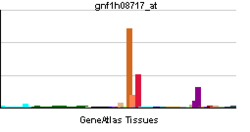ESAM (gene)
| ESAM | ||||||
|---|---|---|---|---|---|---|
| Identifiers | ||||||
| Aliases | ESAM, W117m, endothelial cell adhesion molecule | |||||
| External IDs | MGI: 1916774 HomoloGene: 12316 GeneCards: ESAM | |||||
| RNA expression pattern | ||||||
 | ||||||
| More reference expression data | ||||||
| Orthologs | ||||||
| Species | Human | Mouse | ||||
| Entrez | ||||||
| Ensembl | ||||||
| UniProt | ||||||
| RefSeq (mRNA) | ||||||
| RefSeq (protein) | ||||||
| Location (UCSC) | Chr 11: 124.75 – 124.76 Mb | Chr 9: 37.53 – 37.54 Mb | ||||
| PubMed search | [1] | [2] | ||||
| Wikidata | ||||||
| View/Edit Human | View/Edit Mouse |
Endothelial cell-selective adhesion molecule is a protein that in humans is encoded by the ESAM gene.[3][4][5]
References
- ↑ "Human PubMed Reference:".
- ↑ "Mouse PubMed Reference:".
- ↑ Hirata Ki, Ishida T, Penta K, Rezaee M, Yang E, Wohlgemuth J, Quertermous T (May 2001). "Cloning of an immunoglobulin family adhesion molecule selectively expressed by endothelial cells". J Biol Chem. 276 (19): 16223–16231. doi:10.1074/jbc.M100630200. PMID 11279107.
- ↑ Sim DL, Yeo WM, Chow VT (Mar 2002). "The novel human HUEL (C4orf1) protein shares homology with the DNA-binding domain of the XPA DNA repair protein and displays nuclear translocation in a cell cycle-dependent manner". Int J Biochem Cell Biol. 34 (5): 487–504. doi:10.1016/S1357-2725(01)00156-X. PMID 11906820.
- ↑ "Entrez Gene: ESAM endothelial cell adhesion molecule".
Further reading
- Nasdala I, Wolburg-Buchholz K, Wolburg H, et al. (2002). "A transmembrane tight junction protein selectively expressed on endothelial cells and platelets". J. Biol. Chem. 277 (18): 16294–16303. doi:10.1074/jbc.M111999200. PMID 11847224.
- Strausberg RL, Feingold EA, Grouse LH, et al. (2003). "Generation and initial analysis of more than 15,000 full-length human and mouse cDNA sequences". Proc. Natl. Acad. Sci. U.S.A. 99 (26): 16899–16903. doi:10.1073/pnas.242603899. PMC 139241
 . PMID 12477932.
. PMID 12477932. - Clark HF, Gurney AL, Abaya E, et al. (2003). "The secreted protein discovery initiative (SPDI), a large-scale effort to identify novel human secreted and transmembrane proteins: a bioinformatics assessment". Genome Res. 13 (10): 2265–2270. doi:10.1101/gr.1293003. PMC 403697
 . PMID 12975309.
. PMID 12975309. - Ota T, Suzuki Y, Nishikawa T, et al. (2004). "Complete sequencing and characterization of 21,243 full-length human cDNAs". Nat. Genet. 36 (1): 40–45. doi:10.1038/ng1285. PMID 14702039.
- Zhang Z, Henzel WJ (2005). "Signal peptide prediction based on analysis of experimentally verified cleavage sites". Protein Sci. 13 (10): 2819–2824. doi:10.1110/ps.04682504. PMC 2286551
 . PMID 15340161.
. PMID 15340161. - Gerhard DS, Wagner L, Feingold EA, et al. (2004). "The status, quality, and expansion of the NIH full-length cDNA project: the Mammalian Gene Collection (MGC)". Genome Res. 14 (10B): 2121–2127. doi:10.1101/gr.2596504. PMC 528928
 . PMID 15489334.
. PMID 15489334. - Otsuki T, Ota T, Nishikawa T, et al. (2007). "Signal sequence and keyword trap in silico for selection of full-length human cDNAs encoding secretion or membrane proteins from oligo-capped cDNA libraries". DNA Res. 12 (2): 117–126. doi:10.1093/dnares/12.2.117. PMID 16303743.
- Kimura K, Wakamatsu A, Suzuki Y, et al. (2006). "Diversification of transcriptional modulation: large-scale identification and characterization of putative alternative promoters of human genes". Genome Res. 16 (1): 55–65. doi:10.1101/gr.4039406. PMC 1356129
 . PMID 16344560.
. PMID 16344560.
This article is issued from Wikipedia - version of the 6/6/2016. The text is available under the Creative Commons Attribution/Share Alike but additional terms may apply for the media files.